Want more insight on automated email campaigns?
Share
- Jump to:
As the restaurant industry navigates through an ever-changing physical and digital landscape, we’ve gathered insights on the industry news and trends that defined the year of 2022. Between the transition to automate kitchen operations, scaling out contactless ordering and delivery, and direct food orders growing as a primary source of revenue for brands, restaurants have taken strides forward proving flexibility across the board.
Our Industry Recap for 2022
In honor of restaurants pushing the needle forward day-in and day-out, we want to pay praise to the industry by recapping the monumental movements and everyday trends that ran their course in 2022. From operations, to guest experiences, and more — here is this year's industry recap.
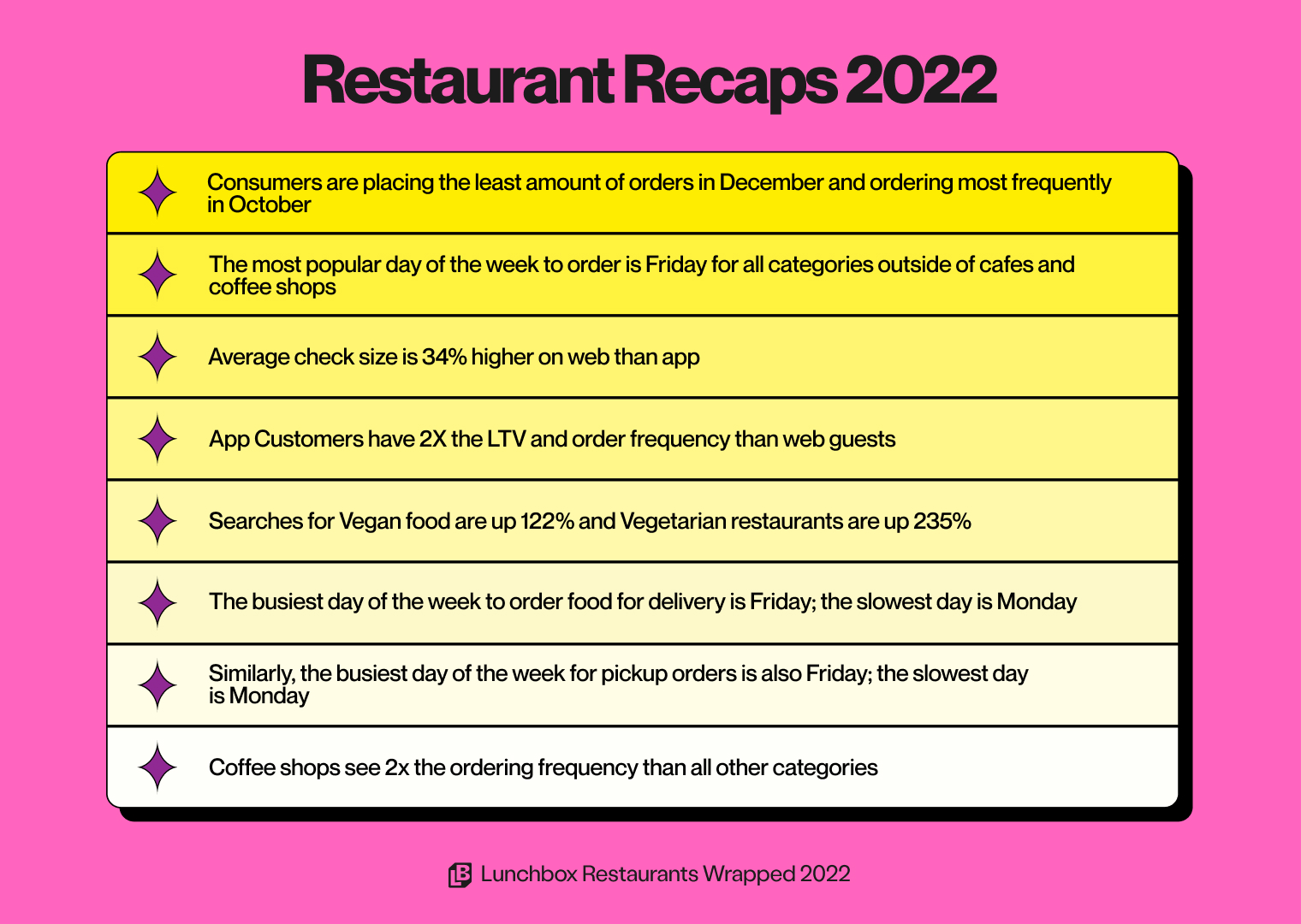
Consumers are placing the least amount of orders in December and ordering most frequently in October
Order volume peaks in October, just before the holiday rush begins. It’s possible that consumers are ditching their summer diets, settling back into routines after summer vacay, and enjoying comfort food as the weather starts cooling down in most parts of the US.
In contrast, it may come at no surprise that December is the slowest month of the year for digital restaurant orders. During the peak of the holiday season, consumers are following a tighter budget to afford gifts for friends and family. Personal treats take a back seat, and order volume tends to not bounce back until the end of February.
The most popular day of the week to order is Friday
With pizza nights, end of the week cooking fatigue, and movie nights — Friday holds the number one spot for the most popular day of the week to order in-store, pickup, and delivery. This is true for all restaurant categories, except for coffee stores, bakeries, and juice brands which see the most traffic on Sundays.
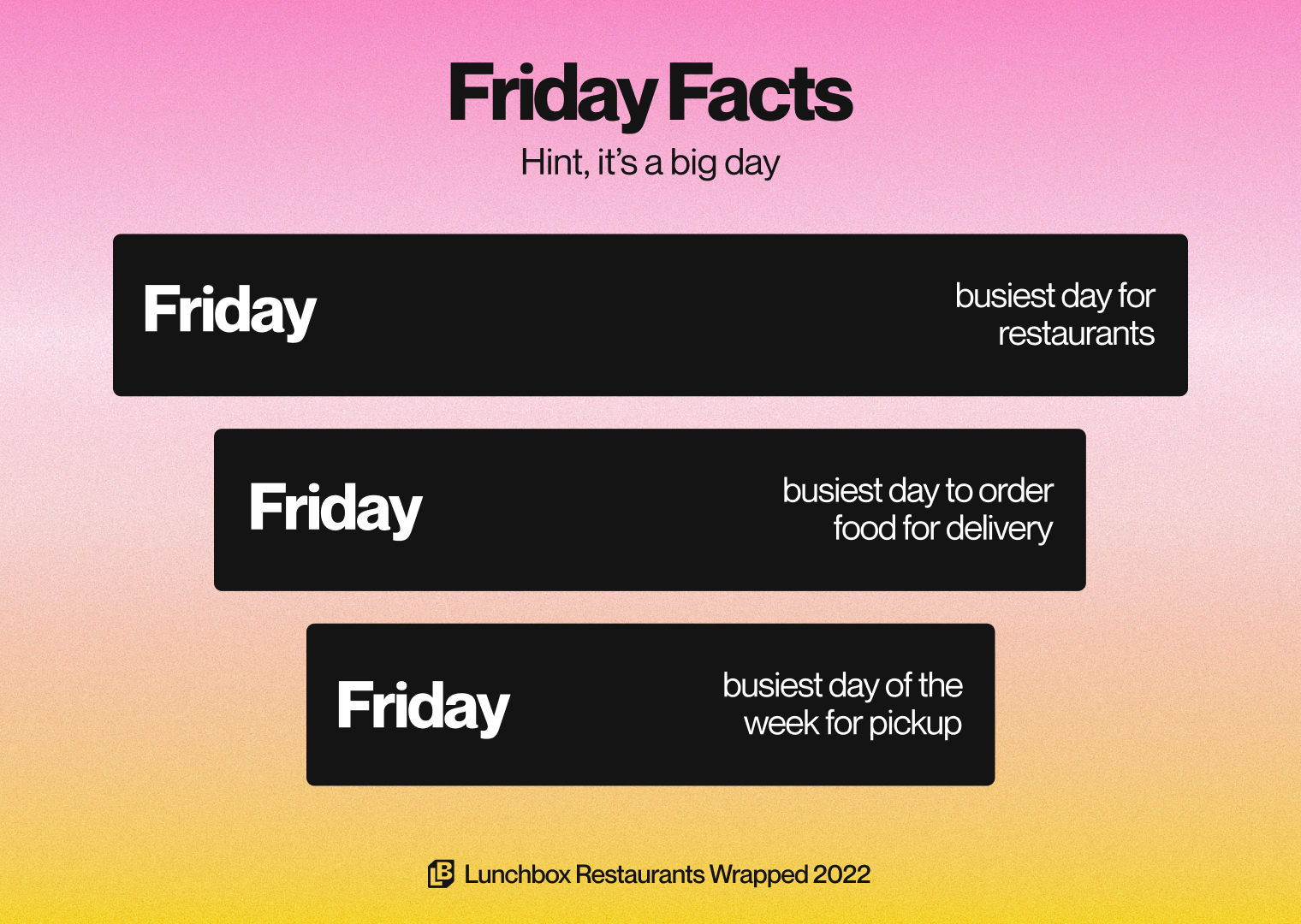
The average distance between a guest and the restaurant when ordering delivery is 1.5 miles
It really isn’t that far — people are willing to pay a delivery fee if it saves them a mile walk. And for 32% of restaurants, the average delivery radius is even shorter than a mile. Your delivery radius is something to keep in mind when planning any paid media campaigns. Avoid wasting advertising dollars by targeting guests who are in closer proximity to your location.
Average check size is 34% higher on web than app
Web remains the highest channel for check size averages across the board, but keep in mind short term vs long term gains. Web will get you higher check averages, but if you want to get the most out of your guests over time: get them ordering on your app. App users are by far more loyal and place more frequent orders compared to web users.
In general, digital guests spend more than in-store guests, regardless of platform. According to QSR Magazine, digital guests at Shake Shack spent 25% more on average than non-digital patrons.
Want to nurture them over your app experience? Once they’re ordering online, start a nurture campaign to get web guests to enroll in loyalty with the aim to eventually download your app. Your app guests are your most loyal guests and will have a higher LTV and order more frequently. These two targeting strategies complement each other and will get you the most out of your patrons.
App Customers have 2X the LTV and order frequency than web guests
Your web and app platforms work together to grow your customer base and get folks ordering more frequently. Web brings in new guests and can help convert them to in-app users, which have shown to generate more spend over time.
Want to get on your future guests’ radar? Start an automated email campaign to nurture web guests to download the app once they’ve placed a few orders via your native platform.
Coffee shops see 2X the ordering frequency than all other categories
Now this one just makes sense. With coffee being the most habitually consumed menu item and a part of many people’s daily rituals, it is one of the only menu items folks will order multiple times a week (and even multiple times a day).
Web ordering leads with the highest check average across all cuisines
Web ordering remains a leading channel for check sizes with an average $36 spent per order across all cuisines, compared to the average $24 spent through app ordering across all cuisines. Web ordering still accounts for mobile browser ordering, so it is important to make sure any/all digital avenues your guests take to order, are built mobile responsive.

People spend the most money per order on Italian food
Viva la pasta. Italian portion sizes tend to be larger and the entrees are priced to reflect, leading to larger than average check sizes compared to all other categories.
People spend the least amount of money per order on Chinese food
But it’s ordered more frequently than other categories. A great dinner choice that’s, both, comforting and feasible to order more than once a month - or week for that matter. Being an inexpensive food category, we found that Chinese food led the way with the lowest check average.
Italian, Cuban, BBQ and Japanese food categories are 122% higher on web than app
Holding the highest gap in check averages between web vs app, these food categories see more large catering orders placed across their web ordering platform. Our assumption here is that app orders are more likely to be placed for a smaller group of people.
Halal, Chinese, Thai, and Hawaiian brands share the smallest gaps in check size between web and app platforms
People's ordering habits tend not to vary in check size, carrying just under a 15% difference across web and app.
Searches for Vegetarian restaurants are up 235%
And Vegan searches are up by 122% compared to previous years. Vegan and Vegetarian lifestyles are on the rise, and Google searches for Vegan/Vegetarian food have drastically increased since last year. Restaurants looking to attract more customers and accommodate dietary restrictions would be smart to add vegan modifiers and items to their menus, as well as having vegetarian options for meatless diners.
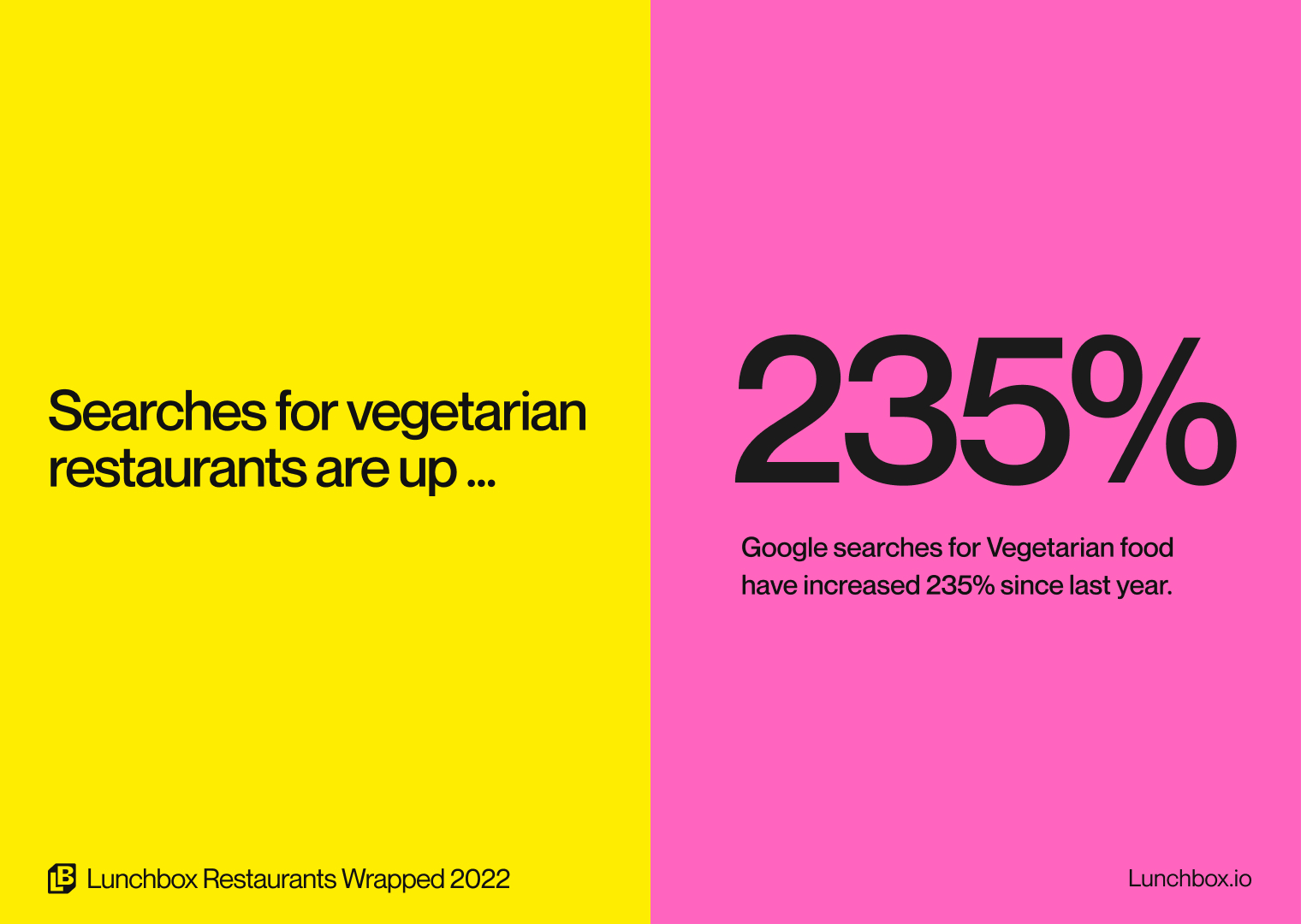
Gen Z led the way with the largest increase in loyalty subscriptions
According to the Paytronix 2022 Loyalty Report, the generation with the largest increase in loyalty subscriptions is Gen Z. Brands kept Gen Z in mind when considering their marketing strategy, loyalty programs, and menu planning this year – the generation’s loyalty numbers grew by a 3rd from 2019 to 2021. It was also noted that the younger generation is going out less often, but spending more when they do.
Dine-in traffic is bouncing back
Dine-in grew by over 2000% this past year when compared to the year before, which comes as no surprise as the world was looking to get back on track after the pandemic with restaurant doors fully open for sit-down guests. However, this didn't stop delivery or pickup orders by continuing their growth over 147% across all restaurant types.
What’s Trending on Menus?
According to National Restaurant Association’s 2023 What’s Hot Culinary Forecast, these items have been gaining the most speed on menus across the industry:
Meals:
Breakfast: Value Meals (coffee + combos)
Lunch: Chicken sandwiches 3.0 (not your basic chicken sandwich, we’re talking spicy and sweet-heat fusion flavors, like Fuku’s spicy habanero brined chicken, etc.)
Dinner: Less-expensive meat cuts to combat inflation (i.e. chicken thighs, beef chuck, pork shoulder, etc.)
Desserts: Alternative sweeteners (maple sugar, coconut sugar, etc.)
Additions:
Snacks: Elevated bar snacks
Appetizers: Charcuterie boards – so popular that Kured launched a concept exclusively around it
Condiment sauce and spices: Sriracha variations
Drinks:
Non-alcoholic beverages: Oat, nut or seed milks (Oat Milk lattes are everywhere, just check out Alfred LA, Blank Street, or any one of Emma Chamberlain’s youtube videos for some inspiration)
Alcoholic beverages: Spritzes
Our Predictions for 2023
With bold strides taken in 2022, we don’t expect restaurants to slow down entering the new year. Here are our restaurant predictions for 2023 based on momentum and trends.
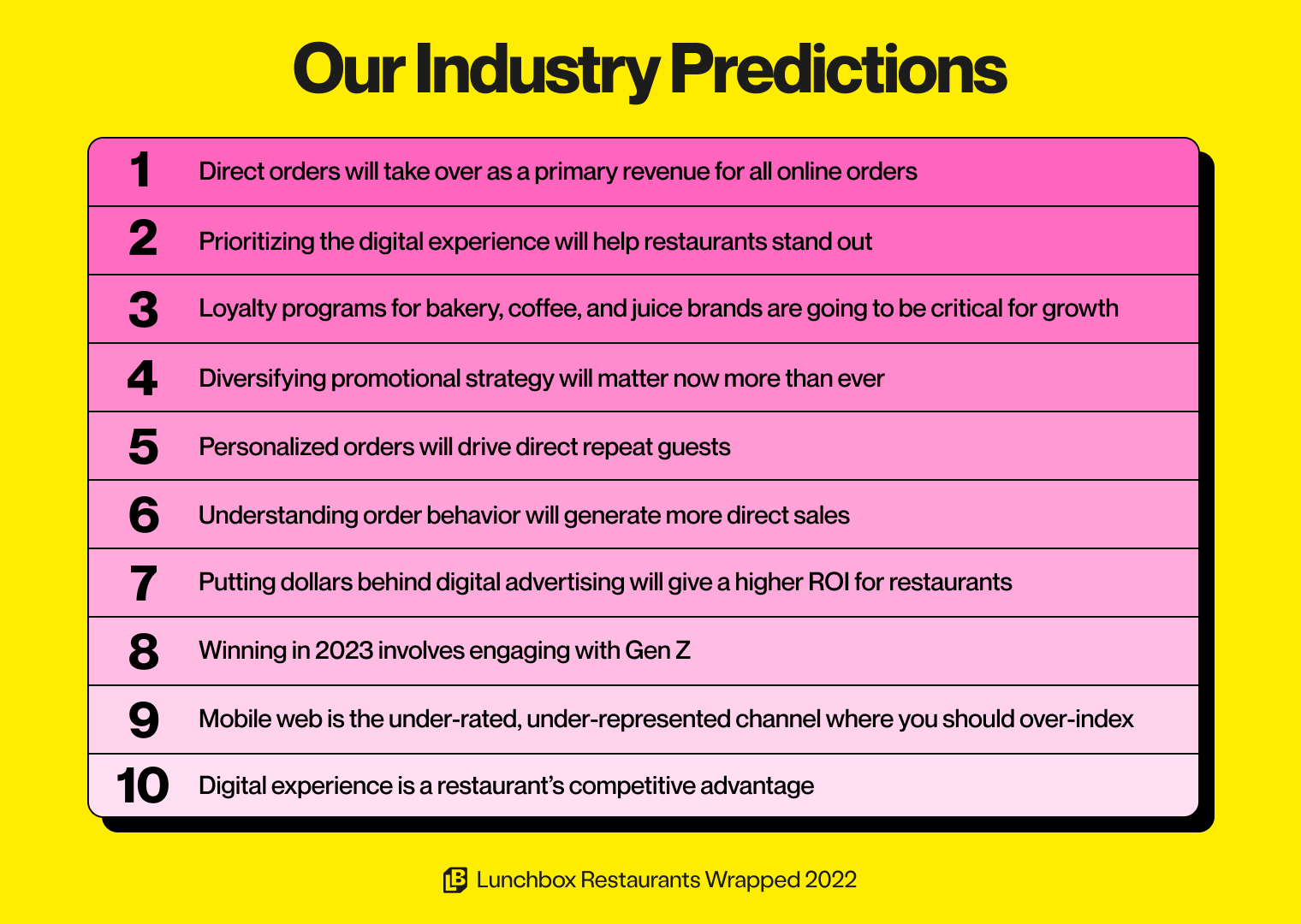
#1 Direct orders will take over as primary revenue for all online orders
We preach this everyday — the guest experience is the most important element to creating repeat and loyal guests. In past years, we’ve seen third-party platforms grow in popularity, but in 2022 we began to see a spike in restaurants offering direct options for their guests.
Between an unfavorable guest experience and a 30% margin on fees, third-party platforms are slowly becoming a thing of the past as restaurants begin to expand their in-house operations. According to Doordash’s 2021 Trend Report, 43% of its customers prefer to order delivery directly through a restaurant's website or app, as opposed to the 27% that prefer to order delivery through third-party platforms.
In addition to controlling the guest experience, restaurants can offer loyalty programs that encourage repeat guests, and thus, repeat revenue.
#2 Prioritizing the digital experience will help restaurants stand out
As we enter a new year, we expect restaurants to prioritize the guest experience at every bend. From the brand's social presence across platforms that attract new guests regularly, to a direct online ordering experience that supersedes current third-party platforms — the guest experience should be nothing short of easy, sleek, and fast.
What we know about the future of the industry is that digital dollars dominate — with 70% of U.S. consumers preferring digital online ordering for off-premise delivery and 79% of people having a restaurant app downloaded, the stakes are high in prioritizing the digital experience for restaurants.
It’s simple: the checkout process should be easy to follow and fast. That means less bugs, more FAQs, and a strong user interface for your guests.

Want more insight on expanding your digital guest experience?
Best Restaurant Website Designs: Examples for Success in 2023
#3 Loyalty programs for bakery, coffee, and juice brands are going to be critical for growth
With guests visiting bakery, coffee, and juice brands as a part of their weekly routines, loyalty and reward programs will be critical for growth in scaling repeat guests and sales. Introducing a strong loyalty program to the menu will reward habit-forming behavior for guests, gamifying the ordering process and giving guests what they want: free food.
Stepping into loyalty programs, there are different incentives that work better for different restaurant types. Specific to routine-like brands (bakeries, coffee shops, and juice brands), spend-based programs are shown to be the most powerful for brands like Starbucks, Dutch Bros, and Peet’s Coffee, showing more repeat guests and higher frequency across the board.
Loyalty programs that we expect to see more across successful bakery, coffee, and juice brands include:
Base programs: Brands that value simplicity can launch a clean Spend X, get Y program and lean into 1-off bonuses (i.e., double point days or wallet drops)
Loyalty bonuses: Brands can utilize one-off rewards to entice guests to spend X amount and receive a free pastry, coffee, or juice
Tiered programs: Brands can gamify their ordering experience and allow guests to reach a loyalty status rank based on their spend habits
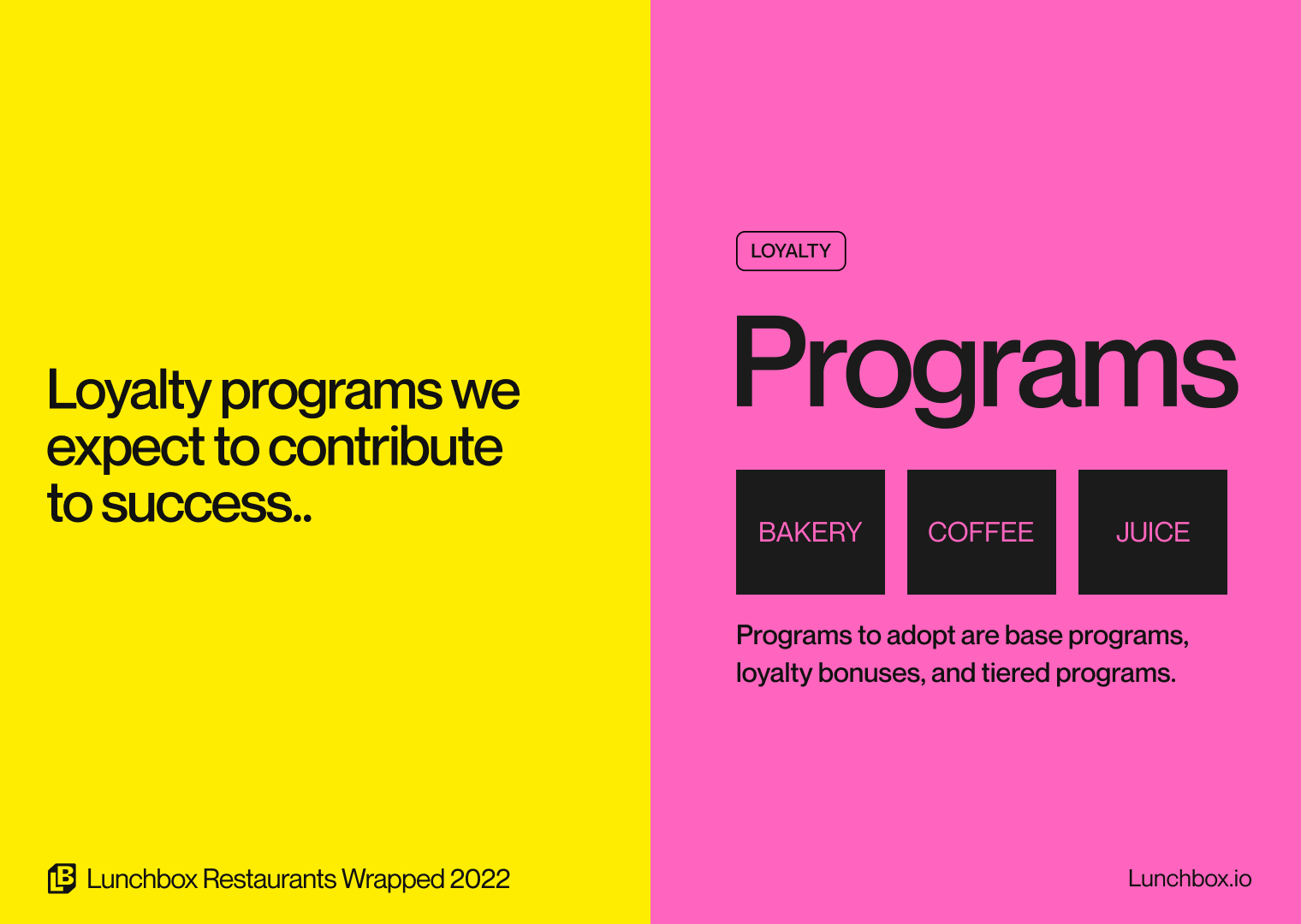
Learn more on tapping into Starbucks-like loyalty programs:
#4 Diversifying promotional strategy will matter now more than ever
Promotional strategy might just read as organic social posts, SMS, and email blasts, but it goes far beyond that. With the ability to re-engage guests and speak to entirely new audiences, the success of your promotional strategies can greatly impact your 2023 revenue.
A big ticket item we expect all restaurants to invest into for 2023 is promo codes. With promo codes regularly altering guest behavior: 43% of guests ordered more after a strong promotion, with returning guests ordering sooner by 5 days.
Restaurant promo code best practices that are linked to success:
Promo codes should be simple for guests
Don’t give away free food; utilize a loyalty or base program
Promo codes should be given to returning guests for higher ROI
Discounts should be equal to <20% of your average check
Don’t run too many promotions simultaneously
Learn more on promotional strategy and promo code best practices:
#5 Personalized orders will drive direct repeat guests
Personalization within your guest experience has proven to be vital this year with expectations to ramp up in 2023. The online ordering experience for guests will continue to invest more into guest data across the board, helping their customization and overall guest experience. We expect restaurants to adopt more personalized newsletters, build-your-own order offerings, custom loyalty programs, and easy-ordering features that speed up the checkout process.
As efforts migrate into the digital space, online ordering will continue to grow more expansive with custom and personalized features that encourage repeat guests and orders.
#6 Understanding order behavior will generate more direct sales
Data is a restaurant's best friend now more than ever. Encouraging new guests to become repeat guests comes down to a science, and generating the right data is vital to its success. With order frequency being an important metric to track, restaurants gain more insight into each grouping of their guests broken down by loyalty level.
Additional units restaurants should track include popular ordering days, app vs web online orders, checkout speed, loyalty usage, abandoned carts, feedback, as well as others. With each metric tracking different operations, restaurants gain measurable insight that they can use to reassess operations and reinvest efforts into marketing that generate sales.
#7 Putting dollars behind digital advertising will give a higher ROI for restaurants
Digital promotional strategy goes beyond the organic social posts that you see. In fact, paid advertisements across popular sites, such as Google, Facebook, Instagram, and Youtube, have generated over 50% more sales than organic content.
Working against a saturated digital landscape, we expect 5 paid advertisement campaigns to continue to perform, promoting an average of 200% ROI for restaurant brands.
Top channels to invest into in 2023 when running paid ad campaigns include:
Google Search
Google Maps
Google Display
Youtube
Facebook / Instagram
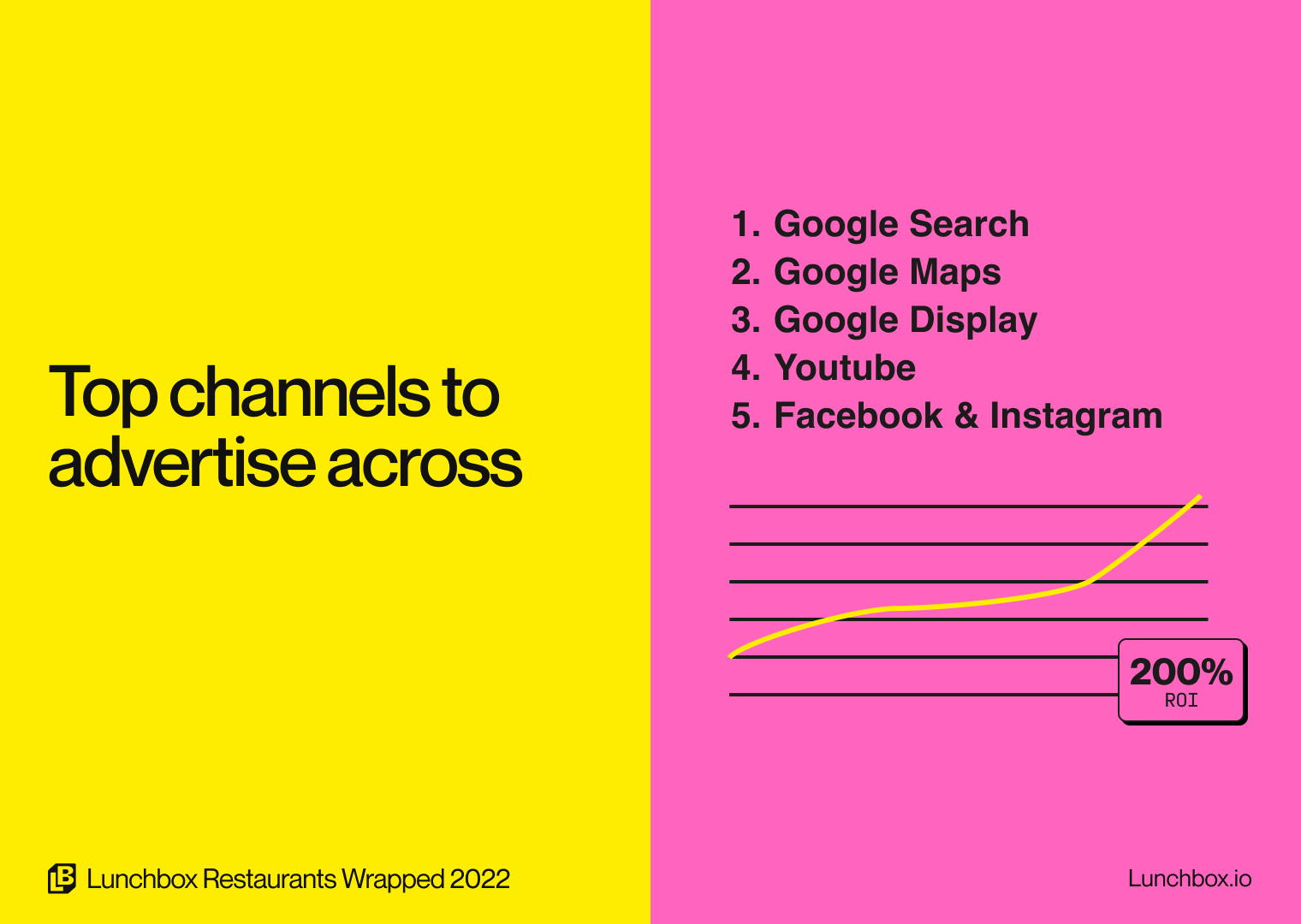
Get insight on the benefits of paid advertisements across different channels:
#8 Winning in 2023 involves engaging with Gen Z
Gen Z led the way this year with the largest increase in loyalty subscriptions. Winning restaurants will build and create their cult following by connecting with their audience on the channels their guests care about: Tiktok and Instagram. Luckily, you won’t have to do twice the work because this content is largely reusable across both platforms.
Invest in your brand and promote your values, mission, and story before talking about sales. Gen Z has a significantly higher affinity for brands who appear trustworthy and transparent. Invest in promoting your brand’s story — it’s the easiest content to make because it should be the core of the company. Partnering with influencers to promote your brand is another way to amplify your story. According to Morning Consult’s Influencer Report, guests aged 15 to 21 are more likely to use influencers (compared to their older counterparts) as a trusted advisor.
#9 Mobile web is the under-rated, under-represented channel where you should over-index
We saw that web orders have a higher check size but app orders happen at a higher frequency. When we take a closer look, over 60% of the web orders happen on a mobile device through a browser (i.e., Chrome and Safari).
We recommend doing a quick test to see how easy you can place an order through your restaurant’s ordering site on your phone. If it’s a painful experience, you’ve identified a gaping hole in your guest acquisition strategy. Aka, you’re leaving over half of your online ordering revenue on the table if you neglect mobile-web.
#10 Digital experience is a restaurant’s competitive advantage
Yes — dine-in is back in its full glory, but that doesn’t mean your digital presence takes a back seat. It’s the opposite: digital experience becomes even more important as we’ve seen digital order volumes continue growing by triple digits. Your digital channels are an extension of your brand and offer more opportunities to delight your guests.
The restaurants who win in 2023 will have exceptional app experiences that make it effortless to order. These restaurants are also able to contextually engage their guests with messages and promotions that reflect their unique preferences and ordering behavior.
And That’s a Wrap
As we wrap up 2022, we’ve seen the restaurant industry transform and move more into the digital space than ever before. Between prioritizing the guest experience, new trends with ordering behavior, and automating kitchen operations, 2022 has been another transformative year for restaurants across the country.
We’re closing out the year by paying praise to the industry and inviting the new trends and restaurants that will be forging the way in 2023 — cheers to the industry and all that comes.